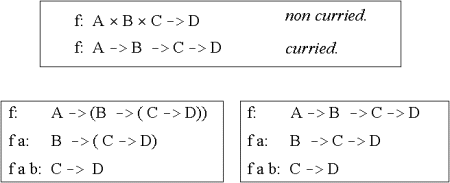 ![Previous page: Currying [Section] -- Keyboard shortcut: 'p' Previous page: Currying [Section] -- Keyboard shortcut: 'p'](./images/nav-left.gif)         | Lecture 4 - Page 21 : 34 |
| Functional Programming in Scheme Higher-order Functions |
|
|
| The idea of currying | Currying is the idea of interpreting an arbitrary function to be of one parameter, which
returns a possibly intermediate function, which can be used further on in a calculation. |
|
 | The signatures of curried functions. In the upper frame we show the signature of a function
f, which takes three parameters. The frames below show the signature when f is curried.
In the literature, the notation shown to the bottom right is most common. The
frame to the left shows how to parse the notation (the symbol -> associates to the right). |
Currying and Scheme is not related to each other. Currying must be integrated at a more basic
level to be elegant and useful |